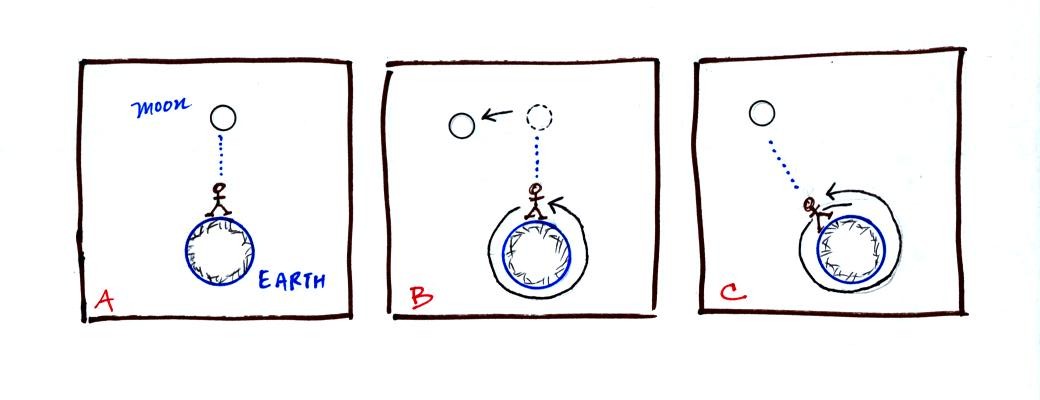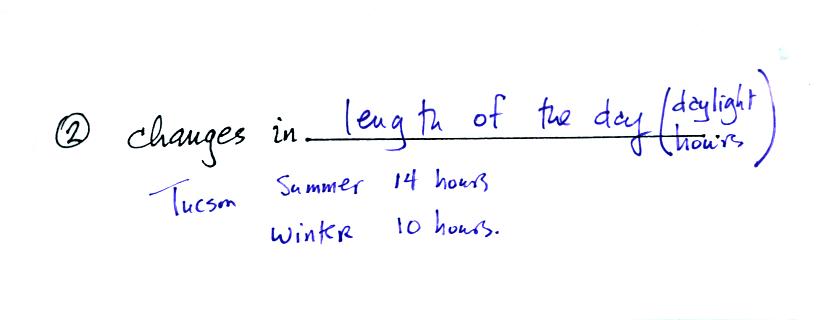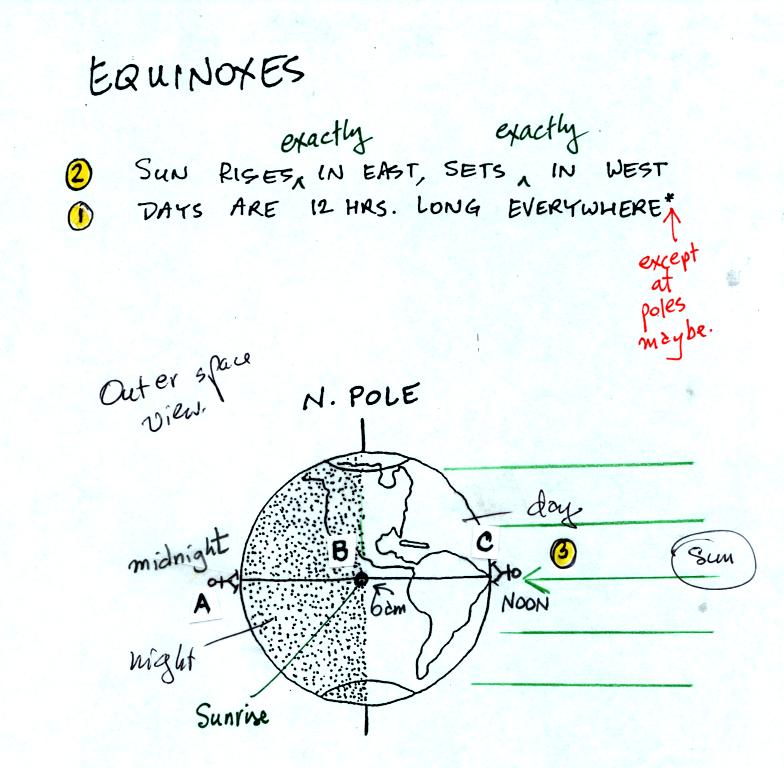Monday Sep. 25, 2006
The Experiment #1 reports were returned in class today. You now
have two weeks to revise and turn your report back in. Revised
reports are due on Mon., Oct. 9. Please
return the original report with your revised report. You only
need to redo sections where you want to earn more credit.
The 1S1P Topic #3 reports have been graded.
A new optional assignment will be handed out on Wednesday. Expect
a new 1S1P Assignment in the next week or so.
Today we
will cover material on the causes of the seasons(found in the second
part of Chapter 2). First a little review.

Many people would have missed the 3rd question. Many people think
the moon orbits the earth in about a day. This is because they
see it in about the same position in the sky on successive
nights. We can see what actually happens in the next figure (not shown in class)
 On the
first night in Fig. A the person looks up and sees the moon. One
day later on
night B, the earth has completed one rotation on its axis and the
person
is looking up at the same point in space. The person doesn't see
the moon in the same position as the night before; the moon has moved a
little bit in its orbit. In Fig. C, a little more than 24 hours
after Fig. A, the person again sees the moon overhead. If you
were to make a note of the time the moon rises you would notice it
rises a little later each successive night.
On the
first night in Fig. A the person looks up and sees the moon. One
day later on
night B, the earth has completed one rotation on its axis and the
person
is looking up at the same point in space. The person doesn't see
the moon in the same position as the night before; the moon has moved a
little bit in its orbit. In Fig. C, a little more than 24 hours
after Fig. A, the person again sees the moon overhead. If you
were to make a note of the time the moon rises you would notice it
rises a little later each successive night.

Many people know that the earth's orbit around the sun is
not circular and that the distance between the earth and sun changes
during the year. Many people think this is the main cause of the
seasons. The earth is closest to the sun on the perihelion (not the perhelion
shown above)
The earth is closer to the sun in January than in
July. If
this were the main cause of the seasons, summer in Tucson would be in
January and winter would be in July. Summer and winter would both
occur at the same times in both hemispheres. Neither of these is
true. The changing
distance
between the earth and the sun has an effect but is not the main cause
of seasonal changes.
The main cause of the seasons is the fact that the earth is tilted with
respect to its orbit around the sun. This is shown in the next
figure.

This figure shows the tilted earth at four locations in its
orbit around the sun. You should be able to start with a blank
sheet of paper and
draw a
picture like this. Note how the N. Pole tilts away
from the sun
on Dec. 21st, the winter solstice. The N. Pole is tilted toward
the sun on June 21. Those are good places for you to
start your sketch. You should also be able to name and attach a
date to each of the four locations.
Before going on, try to imagine what this picture would like if you
moved to the other side of the scene and looked back toward the
sun. Click here for a sketch.
Seasons on the earth are caused by the changing orientation of the
earth relative to the sun. The figure above doesn't really
explain why this is true.

In the summer when the sun reaches a high elevation angle
above the
horizon, an incoming beam of sunlight will shine on a small area of
ground. The ground will get hot. The two people sharing the
shaft of summer sunlight will get a sunburn.
In the winter the sun is
lower in the sky. The same beam of sunlight gets spread out over
a larger area. The energy is being used to try heat a larger
amount of ground. The result is the the ground won't get as
hot. 4 people are able to share the winter sunlight and won't get
burned as quickly.
This difference can be illustrated using three pieces of PVC
pipe. The end of one piece is cut perpendicularly. The ends
of the 2nd and 3rd pieces are cut at 30o and 60o
angles.

The end of the 30o pipe covers twice the area of the 90o
pipe. The
end of the 60o pipe is a little larger but not a lot larger
than area of the end of the 90o
pipe.

As sunlight passes through the atmosphere it can be absorbed
or
reflected. On average (over the globe) only about 50% of the
sunlight arriving at
the top of the atmosphere actually makes it to the ground. A beam
of sunlight that travels through the atmosphere at a low angle (right
picture above) is less intense than beam that passes through the
atmosphere more directly (left picture).

The sun shines for more time in the summer than in the
winter. In
Tucson the days are around 14 hours long near the time of the summer
solstice. In the winter the sun only shines for 10 hours on the
winter solstice. Days are 12 hours long on the equinoxes.
Next we
will look at what happens on the earth on the equinoxes and the
solstices. The situation on the equinoxes is simplest, we will
start there. This is covered on p. 77a in the photocopied class
notes.

There is a lot of information on this figure. We
worked
through this figure numbered point by numbered point. You'll find
written explanations of each point below and on p. 77b in the
photocopied notes.

Notice first of all that you don't see 24 hours of day or 24 hours of
night at the north pole. That is how you know this is one of the
equinoxes and not the summer or winter solstice.
1. The
line separating day from night passes through the north and south
poles. As the earth spins on its axis, a person standing anywhere
on the globe will spend exactly half the day on the nighttime side of
the picture and half the day on the daytime side of the picture.
Thus the day and night are both 12 hours long. This is true
everywhere except at the poles. We'll see what happens at the
poles later.
2.
Imagine standing at the equator. At point A you are positioned in
the middle of the nighttime side of the globe; it is midnight at Point
A. 6 hours later you will be standing at Point B where you will
move from night to day; this is sunrise. To see the sun you must
look exactly back along one of the rays of light coming from the
sun. You must turn and look straight east to do this. One
the equinoxes, the sun will rise in the east (not just somewhere in the
east but exactly due east). This only happens on the spring and
fall equinox. The rest of the year the sun will rise south or
north of east.
3. Six
hours later you arrive at Point C; it is noon. Now to see the sun
you must tilt your head and look straight overhead. The sun
passes directly overhead at noon at the equator on the equinoxes.
THe picture above shows the earth viewed from outer space. We
will next look at the sun's path in the sky viewed from the ground
where most of us will spend our entire lives.

3. This
shows the path of the sun at the equator. The sun rises in the
east at 6 am, passes overhead at noon, and sets in the west at 6
pm.
4. The
cloud shown next to Point 4 above refers to a band of clouds that
circles the globe at the latitude where the sun passes overhead at
noon. This marks the position of the "intertropical convergence
zone (ITCZ)"; we'll learn more about the ITCZ later in the
semester. You can usually make out this band of clouds on a global
satellite picture. At the present time, just a few days
after the fall equinox the band of clouds is near the equator. It
will move south of the equator as we get closer to the winter
solstice. Then it will move back to the equator by next March and
move into the northern hemisphere next summer.
5. Here
is a list of cities that are located on or very close to the equator.

6a. This sun path diagram shows the path that the
sun follows in the sky on the equinoxes in Tucson (or another city
located at 32o N latitude). The sun rises in the east
(just like
it does elsewhere on the globe) at around 6:30 local time, reaches its
highest point in the sky (58o above the southern horizon) at
about
12:30 and sets in the west at about 6:30 pm.

6b. In
the southern hemisphere the sun rises in the east, travels into the
northern sky and then
sets in the west.

7. At Minneapolis the sun rises in the east,
doesn't get quite as high in the sky at noon (only 45o above
the
southern horizon) and sets in the wet. Even though the sun shines
for the same amount of time in Minneapolis as it does in Tucson (12
hours), Minneapolis will receive less energy during the day because of
the lower elevation angle.

8a. At the north pole the sun really
doesn't rise or set. At 6 am you would find the sun right on the
horizon in the east. At noon it would move south. The sun
would be visible at midnight in the north.
8b. The sun circles the sky at the horizon but
in the oppostie direction at the south pole.


 On the
first night in Fig. A the person looks up and sees the moon. One
day later on
night B, the earth has completed one rotation on its axis and the
person
is looking up at the same point in space. The person doesn't see
the moon in the same position as the night before; the moon has moved a
little bit in its orbit. In Fig. C, a little more than 24 hours
after Fig. A, the person again sees the moon overhead. If you
were to make a note of the time the moon rises you would notice it
rises a little later each successive night.
On the
first night in Fig. A the person looks up and sees the moon. One
day later on
night B, the earth has completed one rotation on its axis and the
person
is looking up at the same point in space. The person doesn't see
the moon in the same position as the night before; the moon has moved a
little bit in its orbit. In Fig. C, a little more than 24 hours
after Fig. A, the person again sees the moon overhead. If you
were to make a note of the time the moon rises you would notice it
rises a little later each successive night.











